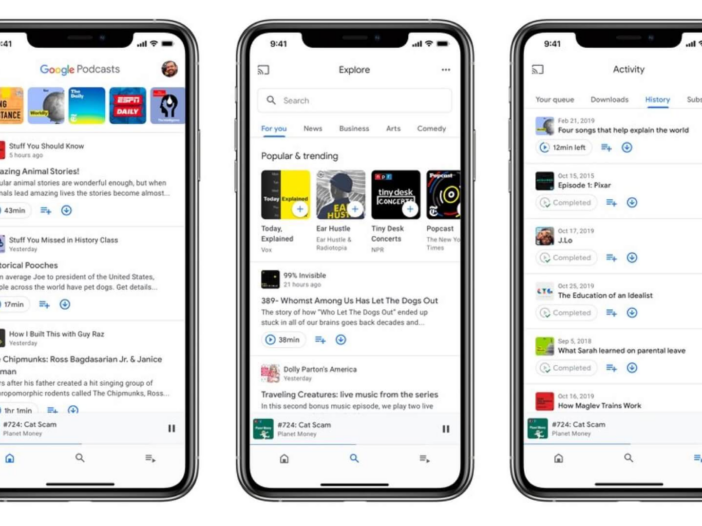Join this leadership discussion for proven techniques to build long-term relationships and keep your clients coming back.
Maximize your SEO efforts in 2024 with insights on Google’s SGE, algorithm updates, and expert tips to keep your site ahead.
Download this guide and learn how to optimize and manage Google Performance Max campaigns, with expert insights and actionable strategies to ensure your campaigns are effective.
Discover the latest trends, tips, and strategies in SEO and PPC marketing. Our curated articles offer in-depth analysis, practical advice, and actionable insights to elevate your digital marketing efforts.
Join three of Reddit’s top executives in this exclusive AMA (Ask Me Anything) to discover how you can tap into Reddit’s unique platform to drive brand growth.
Join this leadership discussion for proven techniques to build long-term relationships and keep your clients coming back.
Google’s Featured Snippets show contradictory information from same sources based on search phrasing, new investigation reveals.
A recent investigation finds that Google’s Featured Snippets may display conflicting information from the same source material, depending on how users phrase their search queries.
This raises concerns about the search engine’s ability to interpret content accurately.
Sarah Presch, director at Dragon Metrics, discovered that Google’s Featured Snippets pull opposing statements from the same articles when users frame questions differently.
For example, searching “link between coffee and hypertension” generates a Featured Snippet highlighting caffeine’s potential to cause blood pressure spikes.
Searching “no link between coffee and hypertension” produces a contradictory snippet from the same Mayo Clinic article stating caffeine has no long-term effects.
Similar contradictions appeared across health topics, political issues, and current events.
The investigation found that asking whether a political candidate is “good” versus “bad” yields dramatically different results despite the fundamental question remaining the same.
“It’s one big bias machine,” Presch notes, explaining how Google’s algorithms appear to prioritize content that matches user intent rather than providing comprehensive, balanced information.
The findings align with internal Google documents from 2016, where engineers admitted, “We do not understand documents – we fake it.”
While Google maintains these documents are outdated, SEO experts suggest the underlying technical limitations persist.
Presch adds:
“What Google has done is they’ve pulled bits out of the text based on what people are searching for and fed them what they want to read.”
Mark Williams-Cook, founder of AlsoAsked, commented on the findings, stating:
“Google builds models to try and predict what people like, but the problem is this creates a kind of feedback loop. If confirmation bias pushes people to click on links that reinforce their beliefs, it teaches Google to show people links that lead to confirmation bias.”
These findings have implications for content creators and SEO professionals:
Google’s spokesperson defended the system, stating that users can find diverse viewpoints if they scroll beyond initial results.
The company also highlighted features like “About this result” that help users evaluate information sources.
Based on these findings, publishers should take the following actions:
As Google moves toward becoming an “answer engine” with AI-generated responses, digital marketers and content creators need to understand these limitations.
Featured Image: Song_about_summer/Shutterstock
Matt G. Southern, Senior News Writer, has been with Search Engine Journal since 2013. With a bachelor’s degree in communications, …
Conquer your day with daily search marketing news.
Join Our Newsletter.
Get your daily dose of search know-how.
In a world ruled by algorithms, SEJ brings timely, relevant information for SEOs, marketers, and entrepreneurs to optimize and grow their businesses — and careers.
Copyright © 2024 Search Engine Journal. All rights reserved. Published by Alpha Brand Media.
The Top 10 Microphones for Podcasting – Search Engine Journal
Join this leadership discussion for proven techniques to build long-term relationships and keep your clients coming back.
Maximize your SEO efforts in 2024 with insights on Google’s SGE, algorithm updates, and expert tips to keep your site ahead.
Download this guide and learn how to optimize and manage Google Performance Max campaigns, with expert insights and actionable strategies to ensure your campaigns are effective.
Discover the latest trends, tips, and strategies in SEO and PPC marketing. Our curated articles offer in-depth analysis, practical advice, and actionable insights to elevate your digital marketing efforts.
Join three of Reddit’s top executives in this exclusive AMA (Ask Me Anything) to discover how you can tap into Reddit’s unique platform to drive brand growth.
Join this leadership discussion for proven techniques to build long-term relationships and keep your clients coming back.
What’s the first step to starting a podcast? Investing in quality podcast equipment! Here are 10 perfect podcast microphones to consider.
Guess what? Podcast content is now part of Google’s SEO indexing.
That’s the good news.
The bad news is if you don’t have a podcast, you’ll miss out on a huge opportunity to gain a larger following, establish your brand, and gain authority online.
So, what’s the first step to starting a podcast?
Investing in quality podcast equipment!
To start, let’s get into the perfect podcast microphone.
Sure, you can start your podcast with your smartphone or the headset you use to make Skype calls.
You can easily upgrade to better gear down the road, right?
But think of this.
Both Apple and Spotify pay special attention to newly released podcasts.
Apple even has a section called new and noteworthy, where it highlights the best podcasts released over a two-week timeframe.
As a podcaster, this is a huge opportunity to grow your following right from the start.
But you can’t be on the new and noteworthy list with podcast content that sounds sharp and tinny.
If you hurt your listeners’ ears, even your standout content won’t make them stick around.
To do things right, start with investing in an excellent recording microphone.
Picking the microphone that’s right for you depends on where you record, how much you’re willing to spend, and the type of podcasts you’ll create.
Here are 10 from different categories.
The Samson Q2U is priced below a hundred dollars, but its quality is a huge jump from what you’d get with your smartphone or headset.
Since it’s a dynamic microphone, your recordings will come out crisp and clear with minimal background noises.
You can also work with the Samson Q2U as you upgrade your podcast gear.
At the beginning, you can simply plug it into your computer through USB.
However, it also has XLR, a connector that allows pro equipment (like a digital recorder or mixer) to be connected to it.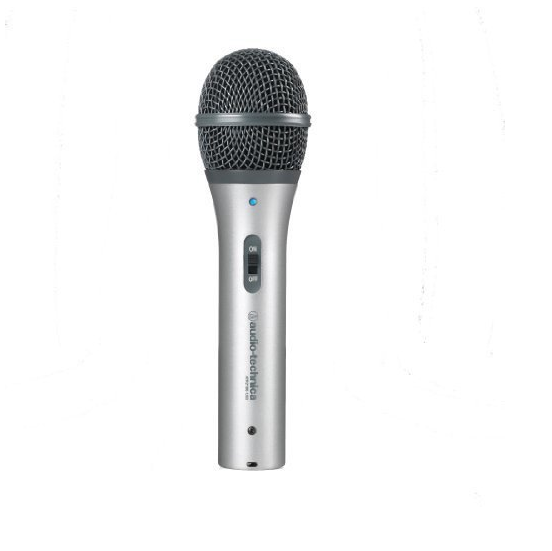
It’s an amazing device!
This is the one I personally use for everything I record, including my narration of my brand new book on Audible.
This microphone is similar to the Q2U.
It can also be connected by both USB and XLR, cancels background noises, and offers good sound quality.
When deciding over this one and the Q2U, it boils down to the microphone’s design.
The ATR2100 is brighter than the standard microphone, with a shiny aluminum body and minimalistic features.
Want to get started on condenser microphones to better catch the nuances of your voice?
At entry level, the MXL 990 is an excellent choice.
Like all condenser microphones, it captures sound in all directions, so you need to use it in a soundproof studio.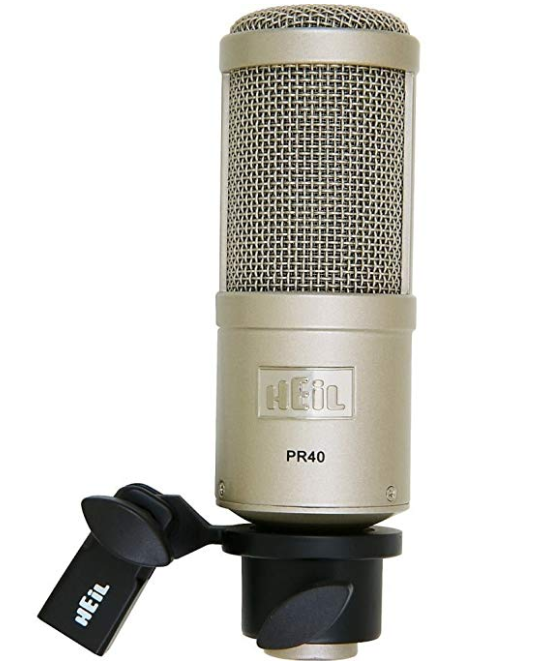
The Heil PR40 is popular with musicians because it captures a wide range of frequency.
This feature is great for podcasters because it allows the microphone to respond extremely well to the entire human vocal range.
What you get is clear, crisp, nuanced sound recordings.
Since it’s a dynamic microphone, it won’t capture a lot of background noise and you won’t have to spend hours refining your podcast episodes.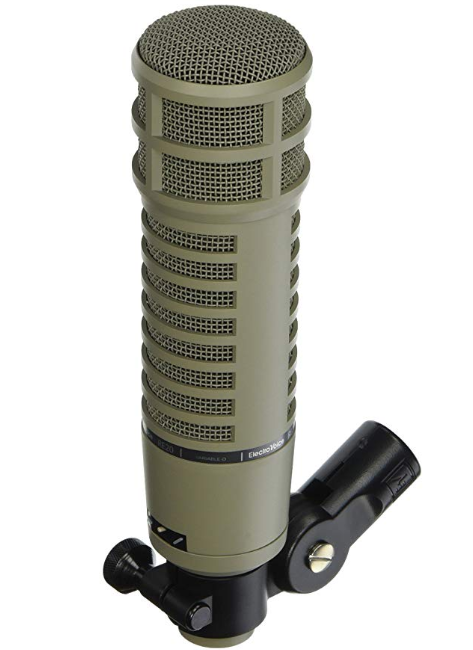
Warning: The Electro-Voice RE20 is not cheap.
It costs more than $400, and that doesn’t include the equipment it needs to function.
However, this is one of the best recording microphones out there.
It captures sound flawlessly, making your recording sound like it’s been cleaned and post-processed.
Its transient response is excellent, allowing it to quickly respond to changes in sound as it records.
It’s also extremely durable, and you don’t need to worry about moisture or heat with this solid mic.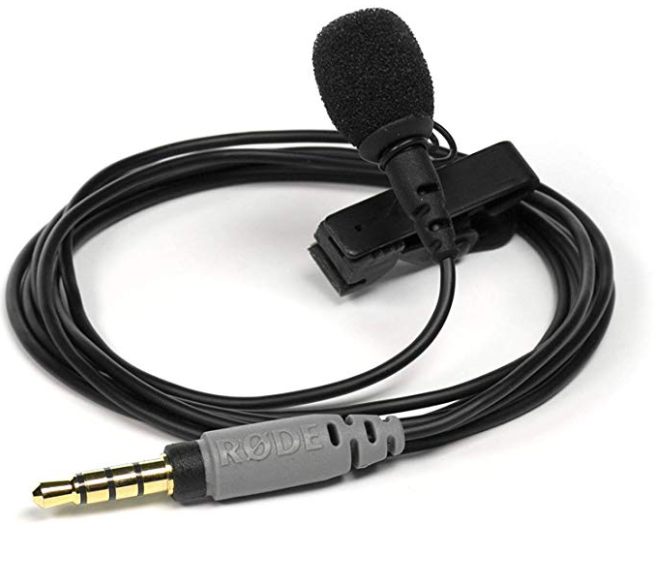
Considering its size, you’ll be surprised how good the Rode Smartlav+ sounds.
Specially designed for use with a smartphone, you can take it with you anywhere for impromptu interviews.
Simply attach the microphone to your shirt, plug the cable into your phone, and you’re ready to go!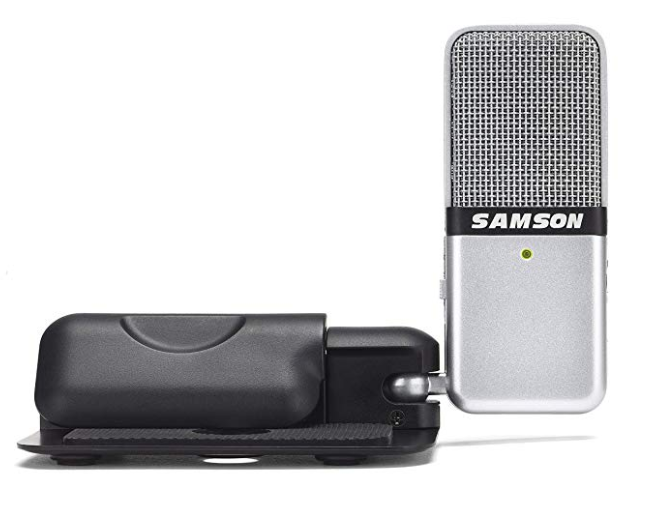
If you prefer a handheld microphone when you record podcasts on the road, the Go Portable Microphone is an excellent choice.
This microphone has an omnidirectional polar pattern, so you can use it if you’re a keynote speaker recording in a large area.
Close-up recordings also work excellently because of its cardioid polar pattern.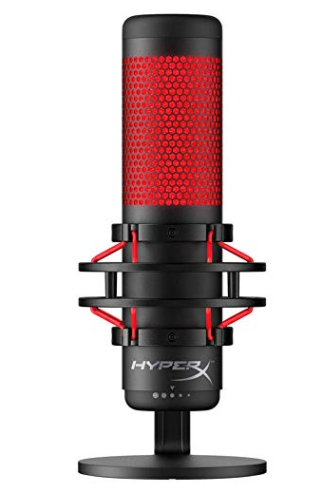
When you livestream, you don’t have time to edit your recording before it reaches your listeners.
In this case, the HyperX Quadcast microphone is the one for you.
The HyperX Quadcast microphone eliminates plosives, the hard consonant sounds like P, T, and K that cause wind noises in your recordings.
With this microphone, you can even record outdoors and still get stellar quality!
The Shure SM7b is highly esteemed by experts and audiophiles. In fact, the legendary Michael Jackson used this microphone to achieve his pristine soundtracks.
If you’re looking for a rich, warm sound, you’ll love what this mic can do for you. However, remember that it’s meant for expert use.
If you’re a beginner and have trouble with breathing noises, lip smacks, and plosive sounds, this intensely sensitive microphone is not the best for you.
The Blue Yeti microphone is great because you can use it to record group, two-person, or solo recordings.
Because it has three different condenser capsules, you can use it either indoors or outdoors. It’s also super easy to use – pull it out of its box, plug it in with either USB or XLR, and start recording!
One size doesn’t fit all when it comes to podcasting microphones. The key to picking the right one is to determine your needs.
Remember, quality sound will pay off in spades once your podcast goes live.
More Resources:
Image Credits
In-Post Image #1: Amazon.com
In-Post Image #2: Amazon.com
In-Post Image #3: Amazon.com
In-Post Image #4: Amazon.com
In-Post Image #5: Amazon.com
In-Post Image #6: Amazon.com
In-Post Image #7: Amazon.com
In-Post Image #8: Amazon.com
In-Post Image #9: Amazon.com
In-Post Image #10: Amazon.com
Julia McCoy is an 8x author and a leading strategist around creating exceptional content and presence that lasts online. As …
Conquer your day with daily search marketing news.
Join Our Newsletter.
Get your daily dose of search know-how.
In a world ruled by algorithms, SEJ brings timely, relevant information for SEOs, marketers, and entrepreneurs to optimize and grow their businesses — and careers.
Copyright © 2024 Search Engine Journal. All rights reserved. Published by Alpha Brand Media.
Google Podcasts gets a redesign and iOS rollout – Search Engine Land
sel logo
Search Engine Land » SEO » Content »
Chat with SearchBot
SearchBot:
The Google Podcast app is now available for iOS devices, and the web version of the app now supports subscriptions, the company announced Wednesday.
Google has also reorganized the app with a tabbed user interface that includes an Explore section where users are shown new show and episode recommendations related to their interests.
Podcast discovery has been a challenge for content creators with most podcast apps showing only what’s available through that particular service. Google’s aim is to provide a comprehensive resource for podcast discovery, including paid content, and library management.
The addition of subscriptions to its web app lets users more easily switch between listening on their desktops and their mobile devices, something that iTunes and Spotify users have been able to do for a long time.
As Google’s podcast platform continues to expand, it’ll become even more important for publishers to manage their presence on search.
Contributing authors are invited to create content for Search Engine Land and are chosen for their expertise and contribution to the search community. Our contributors work under the oversight of the editorial staff and contributions are checked for quality and relevance to our readers. The opinions they express are their own.
Related stories
New on Search Engine Land
About the author
Related topics
Get the newsletter search marketers rely on.
See terms.
Learn actionable search marketing tactics that can help you drive more traffic, leads, and revenue.
Online Nov. 13-14: SMX Next
Available on-demand: SMX Advanced
Available on-demand: SMX Master Classes
Discover time-saving technologies and actionable tactics that can help you overcome crucial marketing challenges.
April 15-17, 2020: San Jose
Get More Out of Your Webinars: Strategies for 24/7 Engagement
How Content is Critical to a Winning Ecommerce Strategy
ABM and AI for Marketers: Priority Use Cases for 2025
Enterprise SEO Platforms: A Marketer’s Guide
Email Marketing Platforms: A Marketer’s Guide
Customer Data Platforms: A Marketer’s Guide
Elevate Your Executive Brand with Proven Social Media Strategies
Meet your new AI-powered marketing assistant!
Get the newsletter search marketers rely on.
Topics
Our events
About
Follow us
© 2024 Search Engine Land is a Trademark of Semrush Inc.
Third Door Media, Inc. is a publisher and marketing solutions provider incorporated in Delaware, USA, with an address 88 Schoolhouse Road, P.O. Box 3103, Edgartown, MA 02539. Third Door Media operates business-to-business media properties and produces events, including SMX. It is the publisher of Search Engine Land, the leading digital publication covering the latest search engine optimization (SEO) and pay-per-click (PPC) marketing news, trends and advice.
SEO Expert Mykola Vyshnevskyi Helps Local Companies Enhance Digital Reach Across Germany – openPR
How to Position Your B2B Brand for Search: Garrett Mehrguth on Marketing Smarts [Podcast] – MarketingProfs.com
hosted by Kerry O’Shea Gorgone
Garrett Mehrguth thinks about search engine optimization (SEO) a bit differently. He focuses not just on keywords and conversions, but on brand awareness.
Don’t miss a MarketingProfs podcast, subscribe to our free newsletter!
His approach to SEO at Directive Consulting, the lead generation-based search marketing company he co-founded, has dramatically increased the company’s own pipeline and helped clients grow their businesses as well.
The agency caters to B2B SaaS enterprises, for which traditional SEO experts wouldn’t consider brand an essential part of the mix for search ranking. But by focusing on building brand awareness through SEO, Garrett argues, you get discovered by people who are looking for exactly what you offer.
I invited Garrett to Marketing Smarts to talk about why it’s nearly impossible today to rank for organic search terms, and to explain how you can position your B2B brand for search.
Here are just a few highlights from our conversation.
Build brand awareness among people with intent (01:49) “The old way, there was this idea that people have to see you in a magazine ad, hear you on the radio, see you on the TV, or whatever…and then, once they know about you, there was no Internet, so there was no way to go out and do your own research. You would literally have to be told what you wanted, and then you’d see it due to product placement, and you would purchase.
“The new funnel works really differently. You and I, we have a need. ‘I need to do X.’ ‘I want X.’ ‘I need help with Y.’ So we have intent and we search and we evaluate. And now we become aware of our options.
The old way was that you would make people aware without intent. And marketers are doing that today. What’s happening is their cost per acquisition is skyrocketing because they have this idea that you make someone aware of you, then they give you their email, and then you turn them from a lead into an opportunity and, eventually, a customer. What if you could cut out the middle part?
“This is based on a customer acquisition cost and an LTV (lifetime value) model. If you put these things into actual financial models, what you find is lead gen, when there’s no intent, is really, really expensive from a cost per opportunity or a cost per deal standpoint. You can get a thousand leads, but if there’s no purchase intent, you’re wasting your money.”
Converting leads from content can be challenging, so focus your SEO on building brand awareness (03:27) “It’s a lot harder than people think to turn a whitepaper lead into a proposal. It just is. And people say, ‘Well, my sales development team really needs them.’ Yeah, but ZoomInfo is 99 cents and theoretically the person who wanted your whitepaper doesn’t read it. Ask your development team, because if they call and talk to these people, they’ll tell you they haven’t read the whitepaper yet. That’s the number one feedback you’ll get.
“And they have no more intent than if you just bought the lead from ZoomInfo, and you paid $17 to get it from LinkedIn. Why pay 17x more for a lead if it has the same purchase intent?
“At Directive, we do SEO and PPC for software companies. I know that my total adjustable market is around 60,000 marketers in software. So why don’t I just build my firmographics and my psychographics on LinkedIn? Then, instead of running traditional in-feed news ads, run spotlight and text ads, get 10 impressions on my ideal customer persona—each, so 600,000 impressions. That’ll cost me only like $2,000.
“Make sure every one of them knows me. And then position myself on a search engine so if they search for an SEO agency, a PPC agency, a SaaS agency, a marketing agency, a digital marketing agency…I show up. And then, when I show up and they’ve heard of me before, now I’m one of the three people they’re talking to. Then, hopefully, because of my positioning, I’ll have a better value proposition than anyone else and I’ll close the deal.”
Stop trying to reach executives and focus on your champions (10:37): “The biggest mistake in B2B marketing is the thought that I need to speak to the decision-maker. It’s the number one mistake I see everyone making. Who you need to speak to is your point of contact, and that’s never the decision-maker in B2B. Your champion is more important than your decision-maker…. Your marketing has to speak to your champion, who will be your future point of contact…. Your sales material is for decision-makers, your marketing material is for your champions.”
To learn more, visit DirectiveConsulting.com. You can also follow Garrett on Twitter at @gmehrguth.
Garrett and I talked about much more, including why thinking about your brand instead of your website is a huge mistake, and how you need to create a human experience or point of contact as soon as you recognize intent, so listen to the entire show, which you can do above, or download the mp3 and listen at your convenience. Of course, you can also subscribe to the Marketing Smarts podcast in iTunes or via RSS and never miss an episode!
This episode brought to you by the MarketingProfs Marketing Writing Bootcamp.
Whether you’re a marketing newbie or a seasoned pro, Marketing Writing Bootcamp’s 13 VIRTUAL sessions (with live keynotes on April 28, May 5, and May 12) will help you level-up your marketing writing fast—from your home or office. Register today with code CAMPSMART to save $100 on your ticket.
“Marketing Smarts” theme music composed by Juanito Pascual of Signature Tones.
…sign up for free to continue reading

Don’t worry … it’s FREE!
Sign in with your preferred account, below.
Don’t miss a MarketingProfs podcast, subscribe to our free newsletter!
Published on March 26, 2020 Garret Mehrguth, a co-founder and the chief executive officer of search marketing agency Directive. Follow Garrett on Twitter: @gmehrguth.
Garret Mehrguth, a co-founder and the chief executive officer of search marketing agency Directive. Follow Garrett on Twitter: @gmehrguth.
Kerry O’Shea Gorgone is senior editor and writer at Appfire. She co-hosts The Backpack Show LIVE with Chris Brogan and Punch Out With Katie and Kerry, and serves as Consigliere and Showrunner for Chris Brogan Media. Once upon a time, Kerry was a lawyer (number one in her class at Suffolk University Law School).
You may like these other MarketingProfs articles related to SEO:
Keep me signed in
Sign in with your preferred account, below.
Over 600,000 marketers rely on MarketingProfs for B2B know-how every day. Don’t miss out on the latest marketing tips and techniques, delivered right to your inbox.
Subscribe today … it’s free!
Sign in with your preferred account, below.
Google Trends: How To Use It For SEO & Content Marketing – Search Engine Journal
Join this leadership discussion for proven techniques to build long-term relationships and keep your clients coming back.
Maximize your SEO efforts in 2024 with insights on Google’s SGE, algorithm updates, and expert tips to keep your site ahead.
Download this guide and learn how to optimize and manage Google Performance Max campaigns, with expert insights and actionable strategies to ensure your campaigns are effective.
Discover the latest trends, tips, and strategies in SEO and PPC marketing. Our curated articles offer in-depth analysis, practical advice, and actionable insights to elevate your digital marketing efforts.
Join three of Reddit’s top executives in this exclusive AMA (Ask Me Anything) to discover how you can tap into Reddit’s unique platform to drive brand growth.
Join this leadership discussion for proven techniques to build long-term relationships and keep your clients coming back.
Google Trends offers insights into how users search, in this guide we cover advanced methods to leverage Google Trends for SEO and content planning
Google Trends is a Google tool that offers a wealth of information that is useful for SEO and content creation.
From real-time search trends to related queries and category insights, Google Trends offers marketers plenty of opportunities to hone their strategy and optimize for better performance.
This article will act as an in-depth guide to Google Trends, covering everything you need to know to leverage it for SEO and content marketing.
You’ll learn what it is, how it’s different from other keyword tools, and what methods you can use to get the most out of Google Trends, so you can grow your traffic and get ahead.
Let’s get started.
[Free Download:] Top PPC trends to shape your 2024 strategy
Google Trends is a tool for analyzing search queries that shows search trends over a period of time, depicted in a graph.
It offers the ability to compare up to five keyword search terms and to tune the results by geographic location, topic, time period, and search surface (image, news, shopping, and video).
There are four selectable ways to customize the keyword data:
Keyword search trends can further be segmented by the following eight time settings:
Google Trends is different from third-party keyword research tools in that it lacks keyword search volume data.
It shows the number of search queries made in percentages on a scale of 0 to 100.
Third-party paid SEO tools do show keyword volumes, but they are only estimates.
Generally, third-party reporting tools purchase data from other providers and then create statistical estimates based on that data. The data providers tend to be software companies that collect anonymous search data from their users.
Google Trends data is derived from a sampling of Google’s actual search data, making it the most accurate keyword search data available. Google Trends uses sampling because the actual volume of data numbers is in the billions and is too much to process.
However, Google reassures that the sampling is representative of actual search volume.
Google explains:
“While only a sample of Google searches are used in Google Trends, this is sufficient because we handle billions of searches per day.
Providing access to the entire data set would be too large to process quickly.
By sampling data, we can look at a dataset representative of all Google searches, while finding insights that can be processed within minutes of an event happening in the real world.”
Although Google Trends doesn’t provide keyword volume data, the tool does provide keyword volume data expressed as a percentage, with 100% representing the highest amount of traffic for the given period of time.
That percentage data can be compared with other keywords with known search volumes.
Known search volumes can be obtained by selecting keyword phrases from Google’s trending searches report, which can itself be tuned to specific geographic areas.
Thus, comparing keywords from the trending searches report against those with unknown search volumes will show an accurate representation of actual keyword volume.
There are two ways to identify trending searches: through Google’s “trending now” webpage and through the Google Trends Explore tool.
Trending now shows the top twenty daily search trends for the current day.
One can click a navigation button to see realtime search trends:
Next, one can select the appropriate country:
Then select the appropriate category:
The available categories to choose from are:
Trending now shows actual top trending keywords. The keywords that are displayed are selected by the Google Trends algorithm.
The second way to find trending keywords is to use the Explore Google Trends tool and set the time period to something relatively recent.
The best time periods to select in order to explore trending searches are:
Something to keep in mind with this second method is that one has to select keywords to explore.
This method will show whether or not those keywords are trending.
[Discover:] Expert insights & actionable tips for PPC in 2024
There are many ways to manipulate the various filters to extract actionable search query data.
One can even use Google Trends to discover new keyword phrases to target.
Google Trends responds to search operators, which change the data that is shown.
There are four search operators:
Related: How To Do Keyword Research For SEO
There are two general ways to look at the keyword data: stretched across over longer periods of time and viewing search interest by shorter time periods.
Long Period Trends
You can set Google Trends to show you the traffic trends stretching back to 2004. This is valuable for showing you the audience trends.
For example, review this five-year trend for WordPress the search term, WordPress the software, and WordPress.org:
There’s a clear downward trend for WordPress in two variations, while the third keyword, WordPress.org, has low search volume overall.
The downward trend is more pronounced when viewed from a longer period than five years:
The downward trend extends to related phrases such as:
There are many reasons why search trends go down. It can be that people have lost interest, the interest went somewhere else, or the trend is obsolete.
The digital camera product category is a good example of a downward spiral caused by a product losing search interest because another product disrupted demand.
Knowing which way the wind is blowing could help a content marketer or publisher understand when it’s time to bail on a topic or product category and to pivot to upward-trending ones.
Related: Content Marketing: The Ultimate Beginner’s Guide
Google Trends has two great features, one called “related topics” and the other called “related queries.”
Topics
Related topics show up when investigating one keyword phrase. It doesn’t show when comparing multiple keyword phrases.
Related topics are search queries that share a concept.
Identifying related topics that are trending upwards is useful for learning how an audience or consumer demand is shifting.
This information can, in turn, provide ideas for content generation or new product selections.
According to Google:
“Related Topics
Users searching for your term also searched for these topics.
You Can View by the Following Metrics
Top – The most popular topics. Scoring is on a relative scale where a value of 100 is the most commonly searched topic and a value of 50 is a topic searched half as often as the most popular term, and so on.
Rising – Related topics with the biggest increase in search frequency since the last time period.
Results marked “Breakout” had a tremendous increase, probably because these topics are new and had few (if any) prior searches.”
Related Queries
The description of related queries is similar to that of the related topics.
Top queries are generally the most popular searches. Rising queries are queries that are becoming popular.
The data from rising queries are great for staying ahead of the competition.
Viewing keyword trends in the short view, such as the 90-day or even 30-day view, can reveal valuable insights for capitalizing on rapidly changing search trends.
There is a ton of traffic in Google Discover as well as in Google News.
Google Discover shows websites on topics related to user interests. This tends to show recently published sites, but it also shows evergreen content, too.
Google News is of the moment in terms of current events.
Sites that target either of those traffic channels benefit from knowing what the short-term trends are.
A benefit of viewing short-term trends (30 days and 90 days) is that certain days of the week stand out when those searches are popular.
Knowing which days of the week interest spikes for a given topic can help in planning when to publish certain kinds of topics, so the content is right there when the audience is searching for it.
Google Trends has the functionality to narrow keyword search query inventory according to category topics.
This provides more accurate keyword data.
The Categories tab is important because it refines your keyword research to the correct context.
If your keyword context is automobiles, then it makes sense to appropriately refine Google Trends to show just the data for the context of auto.
The category to choose for the topic of automobiles could either be Shopping or Autos & Vehicles.
By narrowing the Google Trends data by category, you will be able to find more accurate information related to the topics you are researching for content within the correct context.
Google Trends keyword information by geographic location can be used for determining what areas are the best to outreach to for site promotion or for tailoring the content to specific regions.
For example, if certain kinds of products are popular in Washington D.C. and Texas, it makes sense to aim promotional activity and localized content to those areas.
In fact, it might be useful to focus link building promotional activities in those areas first since the interest is higher in those parts of the country.
Keyword popularity information by region is valuable for link building, content creation, content promotion, and pay-per-click.
Localizing content (and promoting that content) can make it more relevant to the people interested in that content (or product).
Google ranks pages according to who it’s most relevant, so incorporating geographic nuance into your content can help it rank for the most people.
Google Trends allows you to further refine the keyword data by segmenting it by the type of search the data comes from – the search type.
Refining your Google Trends research by the type of search allows you to remove the “noise” that might be making your keyword research fuzzy and help it become more accurate and meaningful.
Google Trends data can be refined by:
YouTube search is a fantastic way to identify search trends for content with the word “how” because many people search on YouTube using phrases with the words “how” in them.
Although these are searches conducted on YouTube, the trends data is useful because it shows what users are looking for.
A Google Trends search for how, what, where, when, why, and who shows that search queries beginning with the word “how” are by far the most popular on YouTube.
Drilling down a bit, I did the same search with a little change to see what that “how” keyword is about.
I swapped out the keyword “how” for the exact match keyword of “how to,” which will show the number of users searching with phrases containing the keywords “how to” in that exact order.
The search trend patterns in Google News are significantly different from those on YouTube.
Audiences, when searching, want to know the “what” and “how” types of information in Google News.
These are examples of how to dig around in Google Trends to find insights, and it doesn’t mean that every news article should be about “what” or “how.”
There are many hidden insights about how people search that can be discovered by selecting the search type and the category from the drop-down menus.
For example, I have found that YouTube search shows more relevant “related topics” and “related queries” data than researching with web search selected.
Give the search type selections a try because the information provided may be more accurate and actionable than the potentially more noisy web search version.
[Recommended Read] → PPC Trends 2024
Google Trends offers many insights about how users search that are useful for SEO and content planning purposes.
There’s a small learning curve to using it, but it’s not that hard to learn and become an expert.
Give Google Trends a try and learn more about how audiences are searching.
More resources:
Featured image by Shutterstock/Catalyst Labs
I have 25 years hands-on experience in SEO, evolving along with the search engines by keeping up with the latest …
Conquer your day with daily search marketing news.
Join Our Newsletter.
Get your daily dose of search know-how.
In a world ruled by algorithms, SEJ brings timely, relevant information for SEOs, marketers, and entrepreneurs to optimize and grow their businesses — and careers.
Copyright © 2024 Search Engine Journal. All rights reserved. Published by Alpha Brand Media.


